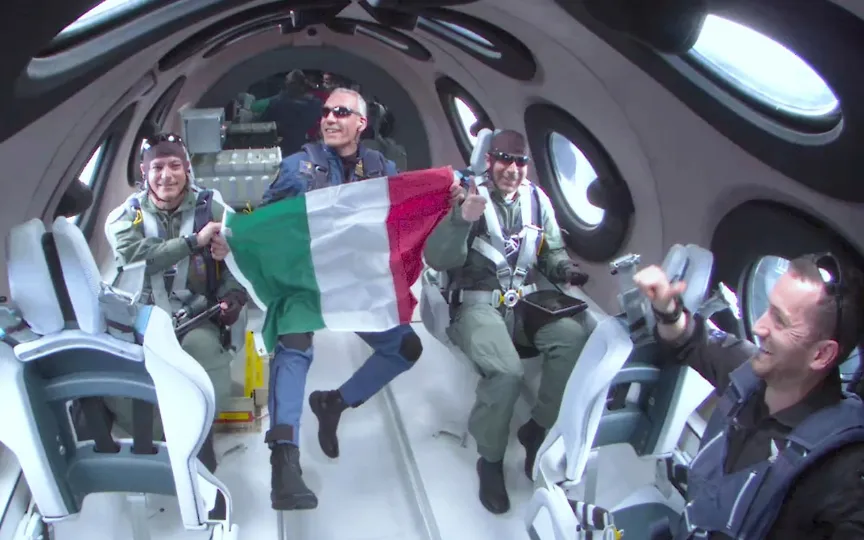Virgin Galactic Takes First Tourists to Space with Richard Branson at the Helm
On Thursday, Virgin Galactic accomplished a significant milestone by safely transporting its inaugural paying passengers to the ultimate frontier. This highly anticipated achievement has reinstated the company’s position in the rapidly growing private space travel industry.
Italian Air Force officers unfurled their country’s flag and looked out the windows at the arc of the Earth, enjoying a few minutes of weightlessness 52.9 miles (85.1 kilometers) above sea level.
“It was a beautiful trip,” Col. Walter Villadei told reporters at a news conference, adding that his favorite moment was seeing the contrast between the blackness of space and the planet below.
The mission, called Galactic 01, began when the giant, twin-hull “mother ship” aircraft took off from the runway at Spaceport America, New Mexico, at around 8:30 a.m. local time (1430 GMT).
The carrier lifted off, then about 40 minutes later released the rocket-powered VSS Unity aircraft, which took off into space at nearly Mach 3.
NASA and the US Air Force consider 50 miles to be the limit of space, although the internationally recognized limit, known as the Karman Line, is 62 miles high.
Along with Villadei in the cabin were Lieutenant Colonel Angelo Landolfi of the Italian Air Force, Pantaleone Carlucci of the Italian National Research Council and Colin Bennett of Virgin Galactic.
There were also two pilots in the spacecraft and two in the carrier.
Unity later glided safely back to Earth, the live broadcast showed.
The flight came nearly two years after Virgin Galactic founder Richard Branson flew into space in a test flight intended to usher in a new era of lucrative space tourism.
But the company later faced setbacks, including a brief grounding by the Federal Aviation Administration (FAA), which found that the Branson flight deviated from its assigned airspace and Virgin Galactic failed to report the “accident” as required.
Laboratory tests later revealed that certain materials used in its vehicles had fallen below the required strength margins, necessitating an upgrade of the vehicle fleet.
The company ended its spaceflight hiatus with a successful test in May, paving the way for Thursday’s mission. It completed a total of five test flights before Thursday’s commercial flight.
– Monthly flights –
The Galactic 01 crew was tasked with conducting 13 controlled and autonomous experiments and collecting data from their suits and sensors in the cabin.
The experiments measured radiation levels in the understudied mesosphere and how certain liquids and solids mix in microgravity.
Villadei explained that researchers who want to work in microgravity currently have only two options: parabolic aircraft, where passengers experience a few seconds of weightlessness, and missions to the International Space Station that last six months.
Virgin Galactic thus provides “gap filling,” he said, and the spacecraft’s size allowed for larger experiments than the rocket could fit.
Founded in 2004, Virgin Galactic has sold about 800 tickets for future commercial flights — 600 between 2005 and 2014 for $200,000 to $250,000 and 200 tickets for $450,000 after that.
Movie stars and celebrities grabbed seats among the first, but the company’s program suffered a disaster in 2014 when a space plane on a test flight disintegrated in mid-air, killing the co-pilot and seriously injuring the pilot.
The company is now looking to the future. The next mission, Galactic 02, is set for August, after which it hopes to make monthly spacewalks.
-Branson, Bezos and Musk –
Virgin Galactic is competing in the field of “suborbital” space travel with billionaire Jeff Bezos’ company Blue Origin, which has already sent 32 people into space on a vertical takeoff rocket.
But after an accident during an unmanned flight in September 2022, Blue Origin’s rocket has been grounded. In March, the company promised to resume space flights soon.
Elon Musk’s SpaceX, meanwhile, has teamed up with partner companies to send paying customers higher up, into Earth orbit or the International Space Station.
But renting a SpaceX rocket is much more expensive. Tickets to the ISS in joint SpaceX-Axiom Space space missions are said to reach tens of millions of dollars.




